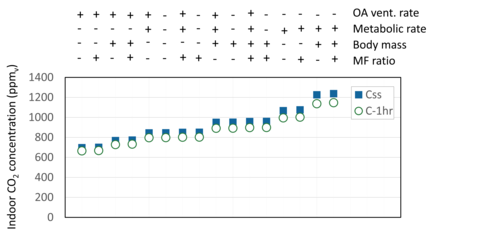Summary
Building ventilation and indoor air quality (IAQ) performance must account for many new challenges, including elevated outdoor pollutant concentrations such as those associated with Wildfire Urban Interface (WUI) smoke and other challenges. Providing effective ventilation and controlling IAQ involves complex relationships, highlighting the need to understand the potential impacts associated with improving IAQ that supports occupant health, safety, and productivity. The existence of these multiple, complex, and interrelated challenges has led to calls for improvements in building ventilation, advancements in IAQ standards, and more flexible and effective strategies for operation and maintenance. Identifying the most effective approaches and their potential impacts requires a deeper technical understanding of the interactions of airflow, energy use, and indoor contaminant transport and the development of new assessment methodologies using advanced building simulation methods and performance metrics. In response to these needs, this project is focused on developing tools, metrics, and data to advance building ventilation and IAQ systems, including supporting changes to existing ventilation and IAQ standards and guidelines and developing new ones that are needed.
Description

Objective:
To develop tools, metrics, and data to enable sustainable, resilient, high-performance building and ventilation system design and operation in response to current and future challenges. Also, to develop a methodology to evaluate potential changes to ventilation and IAQ standards so their impacts can be better understood and evaluated before they are adopted and implemented.
What is the new technical idea?
The design and operation of building and ventilation systems have long been essential to occupant well-being, safety, and productivity through their impacts on building airflows and indoor pollutant concentrations. The role of ventilation system performance and the importance of envelope infiltration have not always fully acknowledged the critical need to maintain IAQ. High-performing buildings with good IAQ can be achieved via integrated design, sound operation, and regular maintenance. Nevertheless, more advanced design approaches and simulation tools are needed to enable such integrated building design. Emmerich and Schoen discussed available tools, and those still required, to support occupant well-being, comfort, and productivity in buildings. They also identified a critical need for tools and data for measuring and verifying IAQ performance. An analysis of the consideration of IAQ in high-performance building case studies and in standards and guidance documents revealed that IAQ was often not addressed in a manner that was consistent with high-performance goals . In response to these needs, metrics of high-performance IAQ are required, which need to include contaminant exposure but also other aspects of well-being including health, satisfaction, productivity, and comfort. Tools for assessing and documenting high-performance IAQ in design, construction, commissioning, and operation are also needed. In addition, the development of ventilation and IAQ standards has been limited by the inability to estimate the impacts of proposed requirements on building energy consumption and occupant exposure, which new simulation tools and metrics would support.
What is the research plan?
The new tools and metrics in response to new ventilation and IAQ drivers will focus on the evaluation of new technologies and approaches to design, operation and maintenance that are being proposed to address hazards of today and tomorrow. Given that discussions of these new drivers have stressed the importance of building ventilation performance, this effort will continue the analysis of approaches to evaluating ventilation in buildings, focusing on the impacts of building configuration and ventilation system design and the industry-consensus standards and guidelines relevant to conducting these evaluations. This project will also continue the review and critical assessment of the technologies, design approaches and O&M strategies that have been recently proposed to manage developing concerns. This assessment will focus on their technical underpinnings, practicality and consistency with current industry standards and codes. Included among these technologies is the use of indoor CO2 measurement to assess ventilation adequacy, which is an implementation of the well-established tracer gas dilution technology described in ASTM Standards D6245 and E741 . Revisions to D6245 were approved to address the more widespread applications of CO2 to assess the adequacy of ventilation. These applications of indoor CO2 require reliable values of the rate of CO2 generation by building occupants that account for their characteristics and the activities in which they are engaged.
Major Accomplishments
- A Collection of Dwellings to Represent the U.S. Housing Stock published
- Quick Indoor CO2 (QICO2) Tool
- IAQ Around the World
Impact of Industry-Consensus Standards and Tools:

